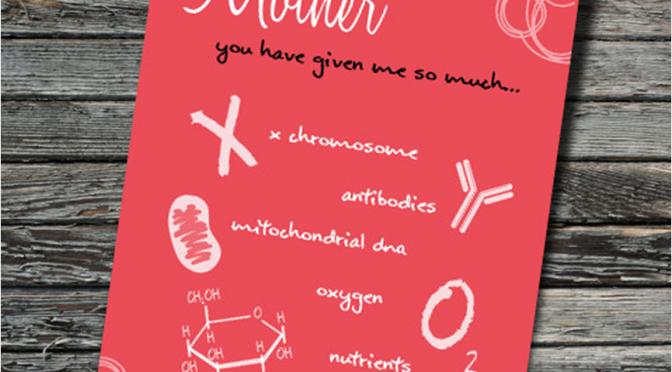Anyone who has been to the supermarket or drug store in the last couple of weeks has been bombarded with commercial reminders that mother’s day is just around the corner. Flowers, mom mugs, and cards all vie for attention next to registers beckoning shoppers to make a purchase and check mother’s day responsibility off the to-do list. When I picked up a tea kettle printed with spring flowers for my own mother, I was thinking of it as a mechanism to express my gratitude for all the love and support she has lavished on me. Having recently produced my own offspring, however, I find myself reflecting on the truly amazing biological processes that must occur in order for us to be here to celebrate mother’s day. So in addition to thanking her for being the amazing person she is, I also thank her for embarking on an amazing biological adventure three decades ago.
The grind of assays, meetings, and deadlines often forces us to narrow our focus exclusively on our own little piece of the biological puzzle such that thinking about the larger pattern becomes overwhelming. This weekend I will be trying to contemplate the biology of motherhood with wonder and appreciation instead of my more typical bewilderment.
As med-bio researchers we are more attuned than most to the incredible number of steps that must take place in near perfect choreography for a healthy living organism to result. Dividing cells talk and cross-talk, differentiate at variable rates, and form functioning organs that allow the growing fetus to become more and more independent. For mammals, cross talk between the maternal system and the fetal system trigger additional developmental programs for lactation in mom that were arrested at puberty. In the hood we are happy if we can get our cultures to remain viable for more than several months. With all the resources of a full organism, cells can still be fully functional decades later without resorting to preservation in liquid nitrogen!
Incidentally, there was a student at Stanford a few years back who was also moved by mother’s day to contemplate the science behind the celebration. He expressed his appreciation much more eloquently than I in a ballad that can be found here on YouTube.
This mother’s day take time to celebrate the positive impact your mother has had in your life and use it also as a day to celebrate eons of evolution that result in modern biology. And don’t forget father’s day and grandparent’s day too!


